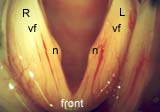Understanding the Disorder | Symptoms | Diagnosis | Treatment | Frontiers
 Related Graphics Related Graphics

 Key Glossary Terms Key Glossary Terms
Vocal Fold Lesions
Specific to this chapter; refers to vocal nodules, vocal polyps, and vocal cysts
Vocal Abuse
Normal vocal behaviors used in excess, leading to vocal fold injury (e.g., excessive loudness or cough)
Vocal Misuse
Abnormal vocal behaviors that cause stress or injury to the vocal folds (e.g., excess tension while speaking)
Vocal Overuse
Normal voice behavior that takes its toll with time (e.g., singer after many years of performing)
Vocal Fold Lesions Disrupt Closure and Vibration
Regardless of type, benign vocal fold lesions – nodules, polyps, or cysts – cause hoarseness by disrupting the vocal fold closure and vibration pattern.
Determining Type of Lesion Important for Management
Determining the type of vocal fold lesion(s) is important since some respond well to voice therapy alone while others require surgical removal.
No Consensus on Vocal Fold Lesion “Vocabulary”
Currently, there is a no uniformity of vocabulary among otolaryngologists regarding vocal lesions, especially in defining vocal fold nodules, polyps, and cysts.
Stroboscopy Is Key to Diagnosis
Stroboscopic examination of the vocal fold lesion(s) is essential for accurate diagnosis and successful treatment.
Surgery Has High Success Rate
Surgery for benign vocal fold lesion(s) can be highly successful when performed with precise phonomicrosurgical techniques. As with all surgery, risk is balanced by benefit – the relief of functional voice limitations – and can be ameliorated by proper planning for surgery and postsurgical care.
No Role for “Vocal Cord/Vocal Fold Stripping”
According to current best practices, there is no role for a type of surgery called “vocal cord/vocal fold stripping” for the treatment of benign vocal fold lesions.
|